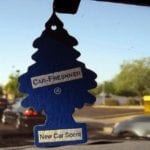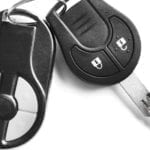It’s easy to see the advantages used cars have over new vehicles. The advantage probably highest on most used car buyers’ lists is the price. Buying a used car can be significantly cheaper than buying a car that’s fresh off of the production line, but when you buy a used car, there is sometimes uncertainty about the car’s history. Understanding a used car’s history before committing to the sale is extremely important. If you don’t get a complete picture of what the car’s been through, you might end up over-paying for a car that isn’t in great shape, or even end up saddled with a car that’s going to cost you more in repairs than you spent in the first place!
Fortunately, there’s an easy way to check out your used car’s history before closing the deal, it’s called CARFAX. Many readers are probably already familiar with CARFAX, you may have even been presented with CARFAX paperwork at your dealership when making a final decision to purchase a used vehicle in the past. If you aren’t familiar with CARFAX, however, it’s important to understand what a CARFAX vehicle history report checks for before signing on the dotted line. And if you aren’t presented with CARFAX report at your dealership, make sure you do your due diligence and ask for one!
Details included in a CARFAX report give you a better understanding of things which you wouldn’t know just by taking the used car for a test drive. Often, a CARFAX report will turn up things even a qualified mechanic wouldn’t have spotted when they inspect the car. So, if you think having your trusted mechanic inspect the used car before you buy it is enough, think again. A CARFAX report lets you step back in time and get to know the used car a little better before committing.
These are some of the major things that a CARFAX report checks for in its vehicle history reports:
Major Accidents
Before you decided to buy a used vehicle, you want to know whether it’s ever been in a major accident. If your CARFAX report turns up with a mention of “major damages,” you’ll want to dig a little deeper. Many reports will give details like “car was driven from the scene.” In cases like this, you can assume the accident left the car with little more than some bumps and bruises. If it was towed from the scene of the accident however, you should check it out before buying. The dealer or your mechanic will be able to tell you whether the paint job on your used car is original or not and check under panels that have new paint. You should also find out if the repair work was done by a “factory” body shop that’s associated with the car’s manufacturer, or whether a low-cost repair shop did the work. This can definitely have an impact on the car’s value and may make you less likely to purchase the used vehicle.
Multiple Owners
A used car that’s had multiple owners isn’t necessarily a bad thing, especially if the car’s a little older, but might be a red flag. If the ownership turn-over seems to be higher than average, find out more details. More owners also means that the used car has more opportunities to have an owner that didn’t have routine maintenance performed. Different owners are likely to have had different driving styles as well, which can cause undue wear and tear on a car and impact its dependability. Used cars with only a single previous owner are considered the best, so keep that in mind when shopping for a used car.
Service History
A used vehicle’s service history will give you a good understanding of its current value. Just because the outside of the car doesn’t have a lot of scraps or dents doesn’t mean that the inner workings are performing well. Things you should be aware of include the used car’s last tire rotation, when the brakes were last services, and if the battery has required any work or replacement? Service records will show you exactly when maintenance was performed, and you’ll be able to check it against the car’s user manual to see if it was taken good care of. You can also see exactly who serviced the vehicle, which can be useful information as well.
Flood Damage
Flood damage is one of the most serious concerns a used car shopper should be aware of. You may assume that a car that has been in a severe flood was sent to the junkyard, but many of these flooded cars are rebuilt and put back onto the market. Often, these cars are sent far away from where the actual flood took place with the hope that prospective buyers won’t know the warning signs to look for. Shady right? If your CARFAX report shows that the used car has been in a flood, you should probably jump ship (no pun intended). Water can ruin electronics, lubricants, and the mechanical systems of cars. Even if it takes months or even years for the problem to manifest itself, flood damage can drastically reduce the life of your used vehicle and make it unsafe to drive, especially if it’s affected airbag controls, something you wouldn’t necessarily think to have a mechanic check.
Branded a Lemon
In the USA, a lemon is a car that is technically new, but has so many flaws and manufacturing defects that it can’t be sold on a regular market. If your CARFAX vehicle history report shows that the used car you’re interested in is a lemon, run! These cars may seem too good to be true because they are almost new and have few miles on them. The truth is that they are too good to be true. Manufacturing defects affect the used car’s safety, value, and usefulness. Do you really want to drive around in a car that had so many severe issues that it couldn’t be sold as a new car?
Mileage Rollback
This is a dangerous thing to see on your CARFAX report and can save you from spending a bunch of money on a car with poor value. Mileage rollback often referred to as “rolling back” or “spinning” an odometer, is when someone tampers with the odometer to make it look like the car has many thousand fewer miles on it. This is particularly common with leased vehicles with mileage limits when their drivers don’t want to pay the penalty for driving more than the allowed amount. Some sellers will also tamper with a car’s odometer to improve the selling value of the used car. If the car actually has 100,000 miles on it already but is showing a mere 30,000, buyers will be more likely to buy at a higher price. Don’t let yourself get scammed and make sure to check the CARFAX for mileage rollbacks before buying.
Here are some other facts that CARFAX vehicle history reports check for in used cars:
- Structural Damage
- Open Recalls
- Registration History
- State Owned
- Total Loss
- Rebuilt
- Warranty Information
- Airbag Deployment
- Mileage Rollover
- Not Actual Mileage
- Salvage Titles
- Hail Damage
- Junked
- Estimated Miles Driven Per Year
- Last Reported Mileage
- Length of Ownership
- Commercial or Personal Use
It’s important to understand a used car’s history before you commit to buying. If you don’t, you could find yourself overpaying for a car that is worth less than it appears or even a car that will put you and your family in danger on the road. Some things that show up on a CARFAX report may be alright with you, minor accidents, etc. Other things might be red flags, however, and keep you from buying. If the seller tries to dissuade you from getting a CARFAX report, take the hint and don’t buy from them! Getting a CARFAX vehicle history report early will likely save you lots of headache down the road.





